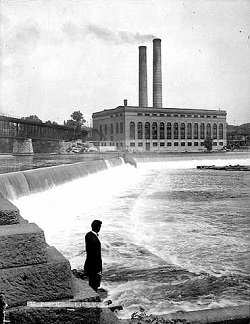The Twin City Rapid Transit Company Steam Power Plant
 Saturday, April 17, 2021 at 6:51AM |
Saturday, April 17, 2021 at 6:51AM |  Michael Rainville Jr |
Michael Rainville Jr | Article by Michael Rainville, Jr.
While wandering across the Stone Arch Bridge and enjoying the downstream view of the Mississippi River gorge, it is hard to miss the four smoke stacks rising from a red brick building on the east bank. The Twin City Rapid Transit Company Steam Power Plant, now known as the Southeast Steam Plant, has played a very important role in the growth of Minneapolis. The original owners of the plant, the Twin City Rapid Transit Company, decided to construct the building in 1903 near the old 6th Avenue Bridge to provide electricity for their rapidly growing company.
 The power plant circa 1906Back tracking a few decades, in 1875, Thomas Lowry bought the failing Minneapolis Street Railway Company and began to finance a project to lay rail on both sides of the river. These tracks would provide public transportation for thousands of Minneapolis residents. Lowry soon bought the St. Paul Street Railway Company and merged the two to make the Twin City Rapid Transit Company. In 1892, the company successfully transitioned from horse powered rail cars to electric powered, and soon averaged 5.5 million riders per year. The high demand created a big problem for their few steam power stations throughout the cities, so Lowry and his New York investors made the decision to build a power station on the east bank of the river, just beneath St. Anthony Falls.
The power plant circa 1906Back tracking a few decades, in 1875, Thomas Lowry bought the failing Minneapolis Street Railway Company and began to finance a project to lay rail on both sides of the river. These tracks would provide public transportation for thousands of Minneapolis residents. Lowry soon bought the St. Paul Street Railway Company and merged the two to make the Twin City Rapid Transit Company. In 1892, the company successfully transitioned from horse powered rail cars to electric powered, and soon averaged 5.5 million riders per year. The high demand created a big problem for their few steam power stations throughout the cities, so Lowry and his New York investors made the decision to build a power station on the east bank of the river, just beneath St. Anthony Falls.
The power plant, which was designed by the Chicago firm of Sargent and Lundy, began construction in December of 1902, and was up and running one year later in December of 1903. While its sandstone bedrock foundations and limestone and red brick walls are a common sight throughout the city, the Second Renaissance Revival style of the building was not. It may not be as ornate as Carnegie Hall or the Dresden Opera House, but it is still an example of remarkable local architecture. On the other side of its imposing façade, generators and boilers ran day and night to power an extensive streetcar system that rivaled San Francisco’s. When Minneapolis converted to buses in the early 1950’s, the Twin City Rapid Transit Company sold the power plant to Xcel Energy, then known as Northern States Power Company, and in 1976, its current owners, the University of Minnesota bought the plant to help power their Twin Cities campus.
The importance of the Twin City Rapid Transit Company Steam Power Plant was recognized on October 18, 1994 when the National Park Service added the building to the National Register of Historic Places. Within a half mile stretch of the Minneapolis riverfront that includes St. Anthony Falls, the Guthrie Theater, and the 35W Bridge, the Twin City Rapid Transit Company Steam Power Plant often gets overlooked. When you visit the University of Minnesota or see old streetcar tracks at the bottom of potholes that seem to pop up every Spring, you’ll be reminded of a cornerstone that helped connect the entire Twin Cities and contributed to Minneapolis’ growth.
- - - - - - - - - - - - - - - - - - - - - - - - - - - - - - - - - - - - - - -
 About Michael Rainville, Jr.
About Michael Rainville, Jr.
A 6th generation Minneapolitan, Michael Rainville Jr. received his B.A. in History from the University of St. Thomas, and is currently enrolled in their M.A. in Art History and Certificate in Museum Studies programs.
Michael is also a lead guide at Mobile Entertainment LLC, giving Segway tours of the Minneapolis riverfront for 5+ years.
He can be reached at mrainvillejr@comcast.net.
